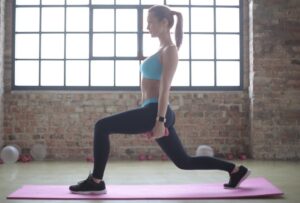A 2 day split is a training schedule where you perform two weekly workouts. The most notable split options are full-body and upper/lower. Full-body on a 2 day split means performing two sessions where you train all major muscle groups in your body. In contrast, a 2 day upper/lower split means doing one lower-body and one upper-body workout each week.
You can also perform a 2 day push/pull/legs program, alternating weekly. For example, you do push and pull one week, then legs and push the next. The downside is the lower training frequency which might lead to sub-optimal results.
Training only twice per week might seem insufficient, but many lifters can make decent progress so long as they do enough work in each workout, push themselves hard, and aim for steady progress (1).
The 2 day split is suitable for beginners because it isn’t challenging to sustain and doesn’t feel overwhelming. But, having two weekly sessions is more than enough to cause an adequate stimulus for muscle growth. Doing 2 day split workouts is also helpful for building strength, provided you include some heavier sets on the bench press and other compound exercises.
What are the Benefits of a 2 Day Split?
The first group to benefit from a 2 day workout routine are beginners. Committing to a couple of weekly workouts isn’t difficult, and gym newbies won’t feel overwhelmed. They are more likely to enjoy their training, remain consistent, and make better progress.
People serious about improving in a specific sport or discipline can also benefit tremendously from a 2 day program. For example, endurance athletes looking to improve their fitness base and performance could perform two full-body workouts to build muscle and get stronger. Doing so can help them overcome a performance plateau and take their endurance to the next level.
Similarly, athletes who practice a specific sport like football, basketball, or volleyball can also benefit from two weekly workouts. A couple of weekly sessions won’t be too demanding to recover from, and they won’t get in the way of training and competing in their sport. But, as with endurance athletes, building some strength and muscle can elevate their performance, making them more competitive.
Busy individuals can also benefit from a 2 day approach. Not everyone has an hour of free time or the ability to follow a 5-day split. For example, you probably won’t have much time to train daily if you’ve had a baby. A 2 day program can keep the momentum going, allowing you to make steady progress until your schedule frees up.

Alternatively, you might find yourself traveling more for work or pleasure. In that case, you won’t always be able to find a decent gym to keep up a high-frequency training approach. As such, committing to two workouts could provide enough structure and keep training on your mind.
What is the Best 2 Day Split Workout Routine?
Many people who want to train twice per week or cannot commit to more sessions wonder which approach is best. Full-body, or perhaps upper/lower?
Full-body training is the obvious choice for most people because you can train all major muscle groups the recommended two times per week (2). Doing so promotes muscle growth and quicker strength gains, leading to superior long-term progress (3). Full-body workouts are also fun and feel more fulfilling because you’re training your entire body instead of splitting up your training.
An upper/lower split is also a good option. One workout focuses on the upper body, and the other is about training your glutes, hamstrings, quadriceps, and calves. This approach makes it easier to focus on fewer muscle groups and train each in a fresher and more recovered state. The only downside is that you’re only training each muscle group once per week.
People who do a lot of leg training outside the gym can leverage a hybrid push/pull/legs split. Instead of doing all three workouts, do one push and one pull session. Doing so would help you develop your upper body without causing excessive leg fatigue that can get in the way of activities outside the gym. Record your 2 day split: push/pull routine with Hevy and track your progress.
Hevy Workout Tracker
Create your own workout splits with Hevy, and track your progress. Join +2M athletes.

For Personal Trainers
Personal trainer software to build workout programs for your clients, and track their progress.
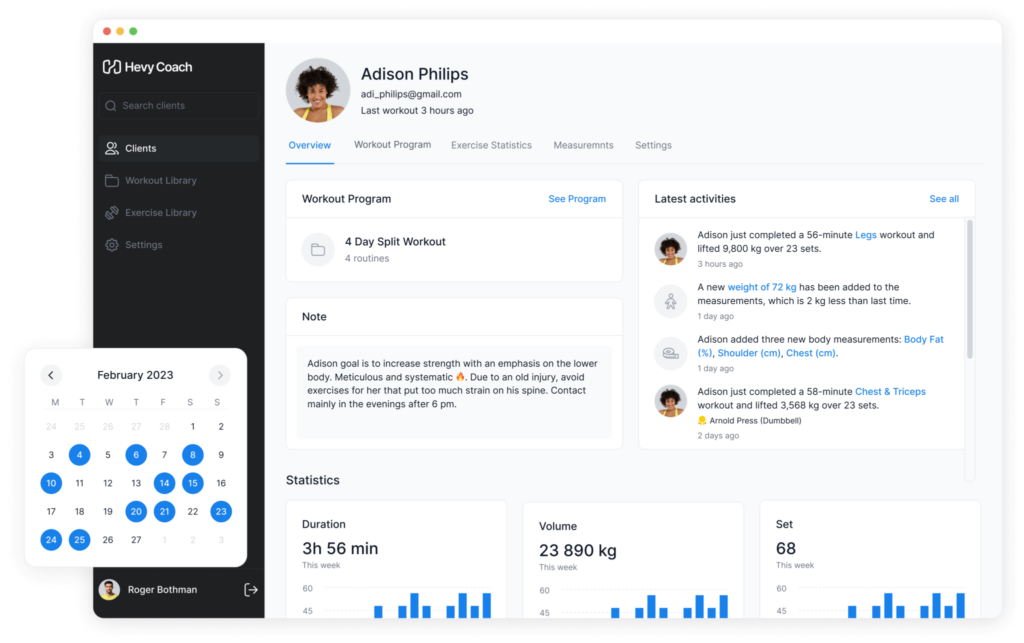


Pros and Cons of the 2 Day Split
Pros
- The approach offers several ways to program your training, including full-body and upper/lower
- Having only two workouts per week means you enjoy great scheduling flexibility and can switch around your training days based on your availability
- Having two full-body workouts per week is enough for most people to make decent strength and muscle gains, so long as they work hard and make steady performance improvements (4)
- A 2 day upper/lower split is also a fantastic option for people because it allows you to focus on fewer muscle groups and accumulate the necessary volume for hypertrophy
- Having two weekly workouts works great for busy individuals because they can still make progress and keep the momentum going without living at the gym
- Twice weekly training works perfectly for athletes and competitors because it leads to progress and makes them more competitive without interfering with their recovery
Cons
- Two weekly workouts might not be enough for more advanced trainees to continue making strength and muscle gains
- A 2 day upper/lower split prevents you from training all muscle groups the recommended two times per week, leading to slower progress (2)
- Full-body workouts tend to be longer and more challenging to recover from, especially if you’re only doing two per week and need to perform more sets to cause an adequate stimulus
- Following a 2 day upper/lower split would mean that your upper-body workouts would have to be much longer and more demanding simply because you must train more muscle groups
- You have limited time to practice the various movements in your training, making it more challenging to develop neuromuscular efficiency and continuously improve your technique
Types of 2 Day Split
Upper/Lower Split
An upper/lower program is one where you split your training into two workouts:
- Upper, where you train all major muscle groups in your upper body (chest, shoulders, triceps, back, biceps, forearms, midsection, etc.)
- Lower, where you train everything below the hips (glutes, hamstrings, quadriceps, adductors, calves, etc.)
The approach works well in a 2 day split because one workout goes for the upper body and another for the lower body.
Level: Beginner/intermediate
| Day 1: Upper | Day 2: Lower |
| Bench Press (Dumbbell) 3 sets of 8 to 12 reps Bent Over Row (Barbell) 3 sets of 6 to 10 reps Seated Shoulder Press (Machine) 3 sets of 10 to 15 reps Lat Pulldown (Cable) 3 sets of 12 to 15 reps Cable Fly Crossover 3 sets of 15 to 20 reps Lateral Raise (Dumbbell) 2-3 sets of 15 to 20 reps Concentration Curl 2 sets of 12 to 20 reps Triceps Rope Pushdown 2 sets of 12 to 20 reps | Squat (Barbell) 3 sets of 6 to 10 reps Romanian Deadlift (Dumbbell) 3 sets of 8 to 12 reps Lunge (Dumbbell) 3 sets of 16 to 30 reps (total) Lying Leg Curl (Machine) 3 sets of 12 to 15 reps Single Leg Hip Thrust 3 sets of 6 to 15 reps (per leg) Leg Extension (Machine) 3 sets of 15 to 20 reps Seated Calf Raise 3 sets of 10 to 20 reps |
Modifications
Your weekly training schedule is the primary thing you can modify on an upper/lower split, especially when doing two workouts. We recommended training on Mondays and Thursdays because you get plenty of time to recover between workouts. If that doesn’t work, you can train Monday-Wednesday, Tuesday-Thursday, Wednesday-Friday, Monday-Friday, or even two days in a row: Monday and Tuesday.
You can also swap movements based on your preferences and available equipment. For instance, if the dumbbell bench press doesn’t work, you can do a barbell or machine press.
The next things you can tweak are the training volume (how many sets you do) and intensity (your repetition ranges). You can adjust the sets up or down based on your ability to recover and experiment with various loads on each movement. For example, instead of doing sets of 8 to 12 on a dumbbell press, do sets of 5 to 8 on a barbell press.
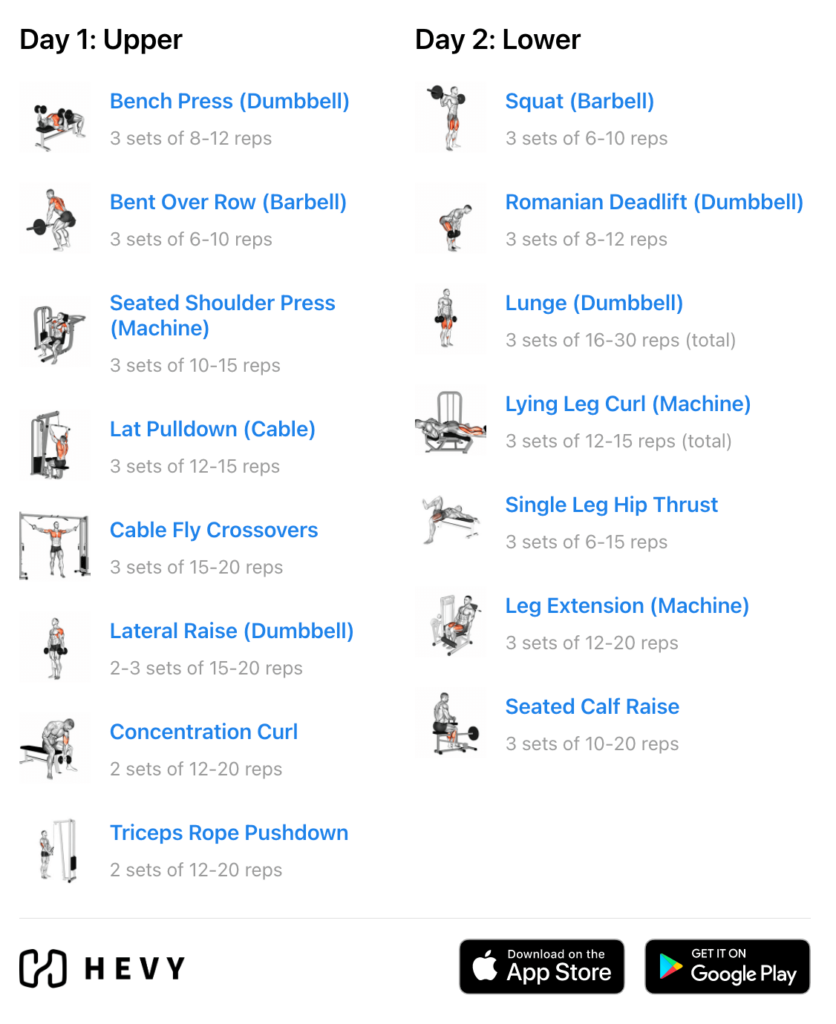

Schedule
Monday – Upper
Tuesday – Off
Wednesday – Off
Thursday – Lower
Friday – Off
Saturday – Off
Sunday – Off
Push/Pull
As briefly mentioned earlier, the push/pull split is beneficial for people who train their lower bodies with activities outside the gym. As such, they don’t need gym training to develop their legs and can stick with upper-body workouts.
The push/pull 2 day split is also helpful because it promotes muscle and strength gain without impairing your recovery or fatiguing your lower body.
Level: Beginner/intermediate
| Day 1: Push | Day 2: Pull |
| Overhead Press (Barbell) 3 sets of 6 to 10 reps Incline Bench Press (Dumbbell) 3 sets of 8 to 12 reps Chest Press (Machine) 3 sets of 10 to 15 reps Butterfly (Pec Deck) 3 sets of 15 to 20 reps Plate Front Raise 2-3 sets of 12 to 20 reps Triceps Extension (Cable) 2-3 sets of 12 to 20 reps (per arm) | Pull Up 3 sets of 5 to 15 reps Meadows Rows (Barbell) 3 sets of 8 to 10 reps (per side) Seated Row (Machine) 3 sets of 10 to 15 reps Straight Arm Lat Pulldown (Cable) 3 sets of 15 to 20 reps Plate Curl 3 sets of 10 to 15 reps Bicep Curl (Machine) 2-3 sets of 15 to 20 reps Face Pull 3 sets of 15 to 25 reps |
Modifications
One modification you can make to the push/pull split is to include a leg day into the equation and alternate between the three workouts. For example, you can do Push and Pull on week one, Legs and Push on week two, then Pull and Legs on week three. Alternating like that allows you to do a push/pull/legs split while only training twice weekly. A notable drawback is that you train your muscles less often, making it challenging to build muscle and get strong at an optimal rate.
Similar to the upper/lower split, you can also pick different exercises, experiment with more or less training volume, and vary the intensity. Doing so is beneficial for keeping your training engaging and understanding what works better for you.
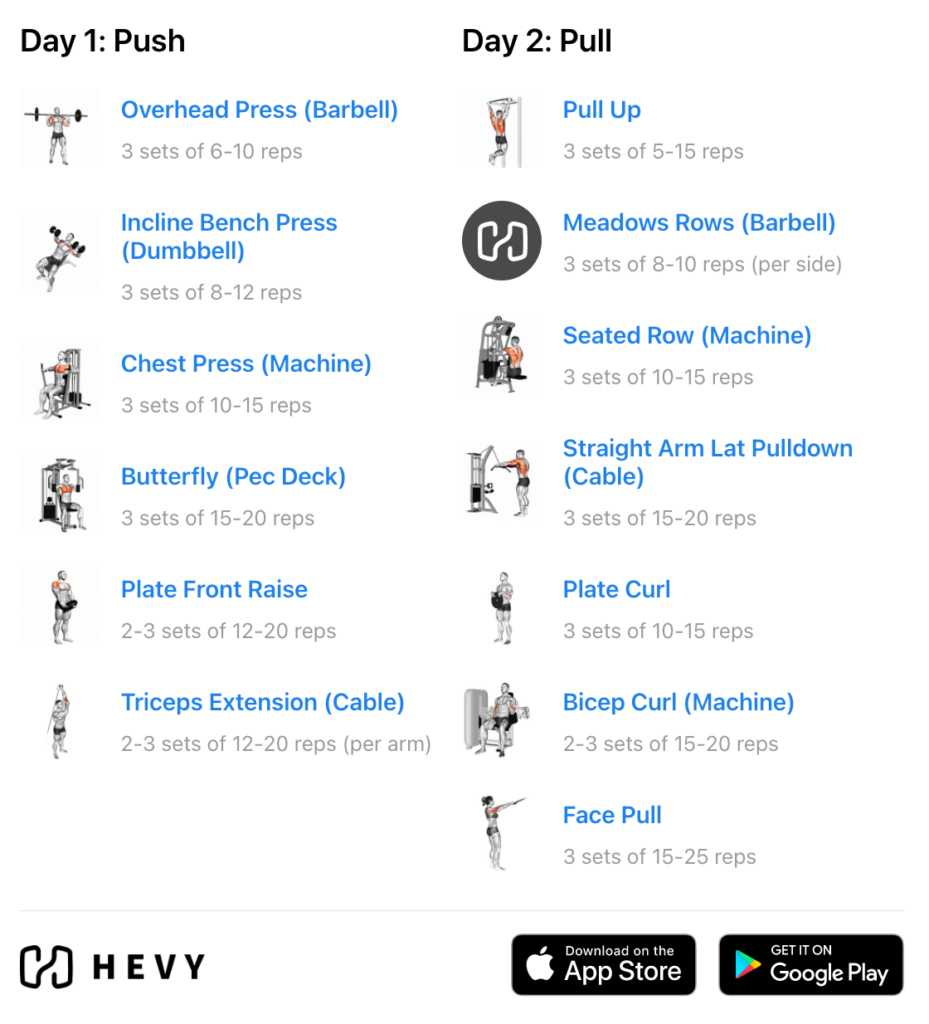

Schedule
Monday – Off
Tuesday – Push
Wednesday – Off
Thursday – Pull
Friday – Off
Saturday – Off
Sunday – Off
Full Body
A full-body approach is the most apparent option for people who can only train twice per week. As its name suggests, a full-body program is one where you train all major muscle groups in your body during each session.
Level: Beginner/intermediate/advanced
| Day 1: Full-body | Day 2: Full-body |
| Squat (Barbell) 3 sets of 6 to 10 reps Incline Bench Press (Dumbbell) 3 sets of 8 to 12 reps Bent Over Row (Barbell) 3 sets of 8 to 12 reps Romanian Deadlift (Dumbbell) 3 sets of 10 to 12 reps Seated Shoulder Press (Machine) 2-3 sets of 10 to 15 reps Leg Extension (Machine) 2-3 sets of 10 to 15 reps Cable Fly Crossover 2-3 sets of 12 to 15 reps Seated Row (Machine) 2-3 sets of 12 to 15 reps Single Leg Hip Thrust 2-3 sets of 6 to 15 reps (per leg) | Overhead Press (Barbell) 3 sets of 6 to 10 reps Goblet Squat 3 sets of 8 to 12 reps Pendlay Row (Barbell) 3 sets of 8 to 12 reps Chest Press (Machine) 3 sets of 10 to 15 reps Glute Ham Raise 3 sets of 8 to 15 reps Lateral Raise (Dumbbell) 2-3 sets of 15 to 20 reps Triceps Rope Pushdown 2-3 sets of 12 to 20 reps Concentration Curl 2-3 sets of 12 to 20 reps Face Pull 3 sets of 15 to 25 reps |
Modifications
While seemingly rigid, a full-body program is flexible and allows many modifications. As with the upper/lower split, the apparent change you can make is when you train, so long as you have at least a day of recovery between the two workouts. Monday-Wednesday, Monday-Thursday, Monday-Friday, Tuesday-Thursday, and Wednesday-Friday are viable options, but there are countless alternatives.
You should also experiment with the composition of each workout to avoid overtraining. Working out all major muscles in your body in one session can be demanding, so blending more challenging movements with easier ones is vital. For instance, if one chest exercise is the bench press, the other should be a chest fly. That way, you can do enough sets for each muscle group without feeling drained when your session ends.
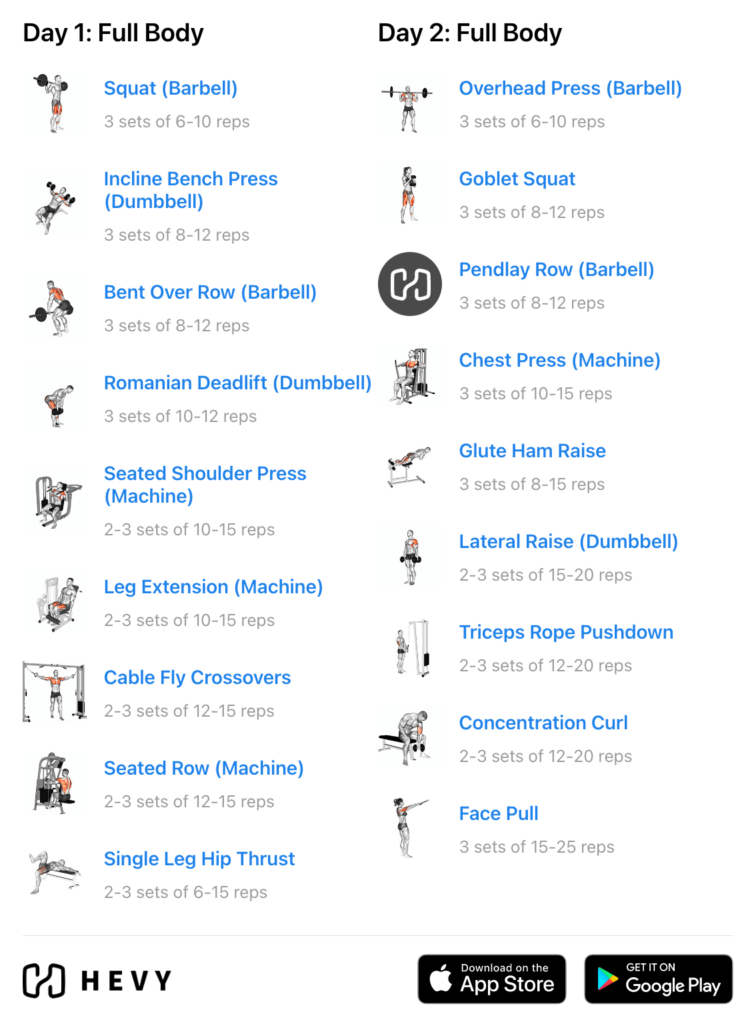

Schedule
Monday – Full Body
Tuesday – Off
Wednesday – Off
Thursday – Full Body
Friday – Off
Saturday – Off
Sunday – Off
Hypertrophy
A hypertrophy program typically features more weekly sessions for good volume allocation, adequate frequency, and recovery of each muscle group. But, a 2 day split can also work, provided you structure your workouts effectively.
We’ve shared a couple of full-body workouts adjusted for hypertrophy training below. Both sessions feature less demanding exercises, and the overall training volume is higher. The objective is to promote hypertrophy without causing excessive neuromuscular fatigue.
Level: Intermediate
| Day 1: Hypertrophy | Day 2: Hypertrophy |
| Chest Press (Machine) 3 sets of 10 to 15 reps Bent Over Row (Barbell) 3 sets of 10 to 12 reps Leg Press (Machine) 3 sets of 10 to 15 reps Seated Shoulder Press (Machine) 3 sets of 10 to 15 reps Glute Ham Raise 3 sets of 10 to 15 reps Chest Fly (Machine) 2-3 sets of 15 to 20 reps Seated Row (Machine) 2-3 sets of 12 to 15 reps Leg Extension (Machine) 2-3 sets of 12 to 20 reps Standing Calf Raise (Machine) 2-3 sets of 15 to 20 reps | Shoulder Press (Dumbbell) 3 sets of 10 to 12 reps Bulgarian Split Squat 3 sets of 10 to 15 reps (per leg) Inverted Row 3 sets of 5 to 15 reps Incline Chest Press (Machine) 3 sets of 12 to 15 reps Lying Leg Curl (Machine) 3 sets of 12 to 15 reps Lateral Raise (Dumbbell) 2-3 sets of 15 to 20 reps Triceps Rope Pushdown 2-3 sets of 12 to 20 reps Bicep Curl (Machine) 2-3 sets of 12 to 20 reps Face Pull 3 sets of 15 to 25 reps |
Modifications
The hypertrophy split is similar to the full-body one, but the one difference is that you’re doing more assistance and isolation movements while training with lighter weights for more reps. A modification you can make is to introduce some heavier sets at the start of each workout. Doing so can be beneficial for gaining more strength and providing the necessary overload for optimal muscle gain. For example, lift more weight during the chest press and bent-over row, doing 6 to 10 reps per set, then proceed with Day 1 as outlined.
You can also switch some movements if you don’t have the necessary equipment. For instance, leg extensions are an excellent isolation movement for the quadriceps, but you can do lunges, split squats, step-ups, or bodyweight squats instead.
As with all other 2-day splits, you can also change your training schedule, so long as you have at least a day of recovery in-between.
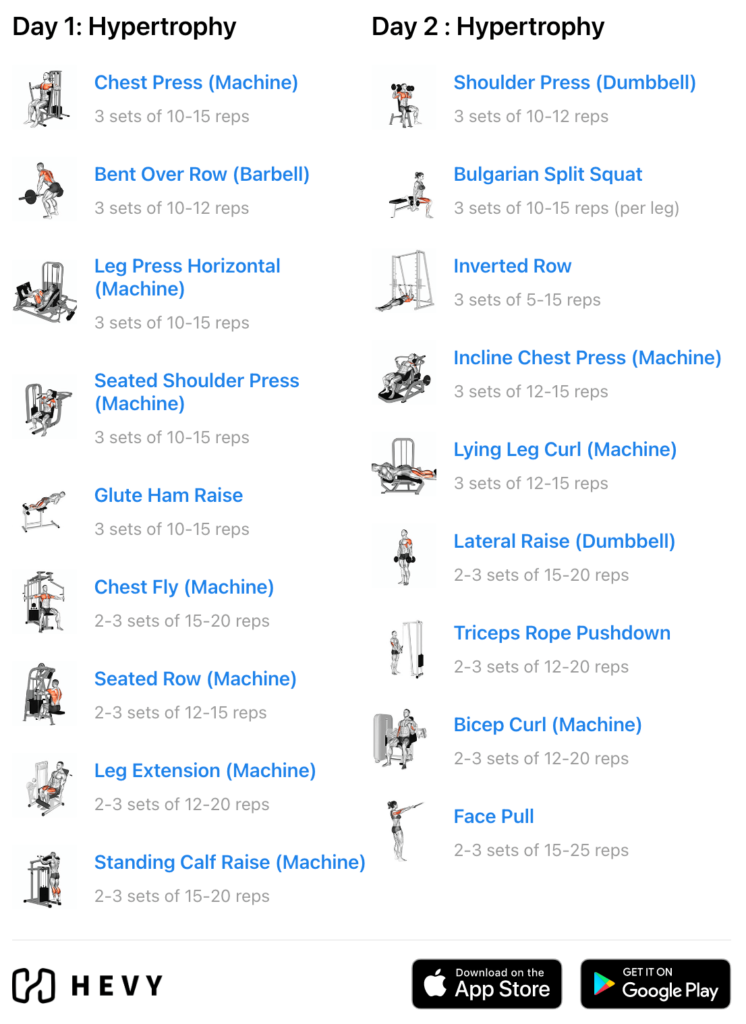

Schedule
Monday – Full Body
Tuesday – Off
Wednesday – Off
Thursday – Full Body
Friday – Off
Saturday – Off
Sunday – Off
Bodyweight
Bodyweight training is a viable way to train at home and on the road. You can pick from countless exercises and variations to put together workouts that fit your athletic level and preferences.
Level: Beginner/intermediate
| Day 1: Bodyweight | Day 2: Bodyweight |
| Pull Up 3 sets of 5 to 15 reps Push Up 3 sets of 5 to 25 reps Bulgarian Split Squat 3 sets of 5 to 20 reps (per leg) Pike Pushup 3 sets of 5 to 15 reps Single Leg Hip Thrust 3 sets of 6 to 15 reps (per leg) Inverted Row 2-3 sets of 5 to 20 reps Jump Squat 2-3 sets of 10 to 25 reps Single Leg Standing Calf Raise 2-3 sets of 15 to 30 reps (per leg) | Pike Pushup 3 sets of 8 to 20 reps Assisted Pistol Squat 3 sets of 5 to 15 reps (per leg) Chin Up 3 sets of 5 to 15 reps Decline Push Up 3 sets of 5 to 20 reps Nordic Hamstring Curls 2-3 sets of 5 to 15 reps Inverted Row 2-3 sets of 5 to 15 reps Bench Dip 2-3 sets of 8 to 20 reps |
Modifications
The beauty of bodyweight training is that you can modify all the variables to fit your needs, goals, and fitness level. An obvious modification you can make is with the exercises you do. Almost all bodyweight movements have more accessible and more challenging variations, allowing you to put together workouts that provide the right level of challenge.
For example, if regular push-ups feel too easy, do decline, plyometric, weighted, or one-arm push-ups. Conversely, if push-ups feel too difficult, do knee or wall push-ups to build strength. The same goes for other movements like squats, pull-ups, dips, and more.
You can also change what days you train on, modify the training volume, and experiment with various exercises to tweak the intensity. For example, instead of doing sets of 10 reps on chin-ups, attach a weight to yourself and do 5 reps at a time. Doing so is a great way to keep your training engaging and overload your muscles for strength gain.
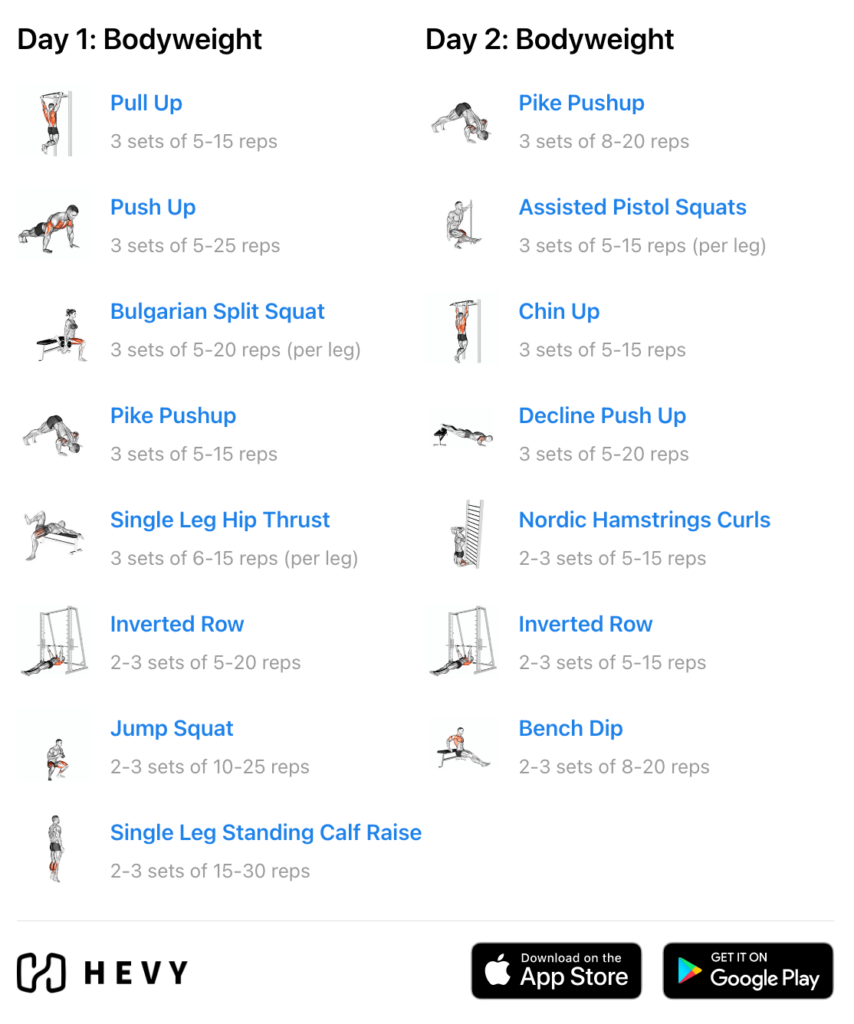

Schedule
Monday – Off
Tuesday – Bodyweight workout
Wednesday – Off
Thursday – Off
Friday – Bodyweight workout
Saturday – Off
Sunday – Off
Importance of a Workout Plan and Rest Days
Having a specific workout plan is necessary for knowing what you’ll be doing each week, leading to more motivation to stay consistent. Plus, you feel more accountable because you will see what you’re missing if you decide to skip a workout.
The next benefit of having a workout plan is having clearly outlined rest days. These are essential for giving your body the time to recover from the demanding training and adapt positively. Training daily might seem like a great idea but doing so leaves you no time to recover and increases the risk of overtraining or getting injured.
Taking rest days doesn’t necessarily mean sitting on the couch all day. You can stretch your muscles, go for a walk, do some light cardio, etc.
Combining Muscle Groups for the 2 Day Split
There are countless ways to combine muscle groups, but that might be challenging when you only train twice per week. Let’s go over some options.
Back, Bicep, and Legs
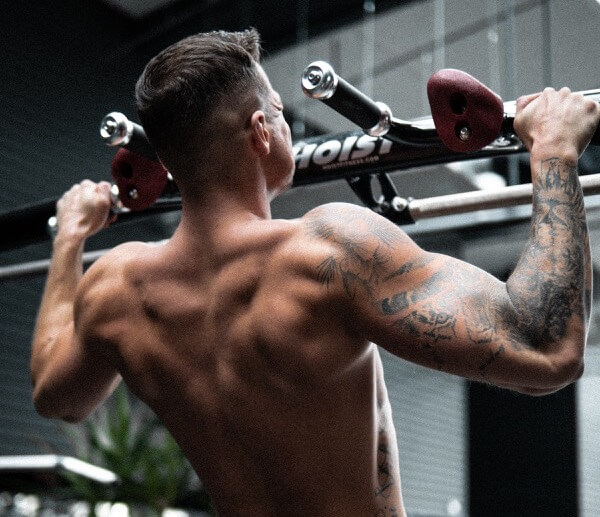

Training back and biceps is a common approach, and you can include some leg exercises if you’re only training twice per week. The objective would be to do your back and leg exercises first and spend most of your training on these two areas. You can then conclude the workout with some biceps isolation exercises.
Chest, Shoulders, and Tricep
The chest, shoulders, and triceps are muscles that work together on various exercises (such as the bench press), so training them in the same workout makes sense. You should spend most of your time on chest and shoulder exercises and finish the workout with some triceps isolation work.
Full Body
Full body training provides you with many options for putting together workouts, and you can prioritize any muscle group or exercise. You can start with a movement for the back, chest, shoulders, or legs.
Don’t do too many exercises and pick easier movements as the workout progresses. For instance, start with deadlifts, but finish with leg curls, lateral raises, chest flyes, or similar.
Is the 2 Day Split Workout for Me?
A 2 day split is helpful mainly for beginners because they don’t need as much training to progress. Plus, having only two workouts is good for motivation and prevents beginners from becoming overwhelmed. The split can also work for the more advanced trainees, but they would benefit from a higher training frequency because it allows for better volume allocation.
Goal: Lose Fat
Losing fat is about creating and sustaining a calorie deficit, but you must also practice weight training and eat enough protein to maintain muscle mass (5, 6, 7). A 2 day program can work for fat loss because it provides the necessary stimulus to protect muscle without leading to overtraining.
You can increase the amount of weight you’re using on compound exercises and perform fewer reps per set. As you diet for a couple of months, you can even remove some of the accessory and isolation movements to reduce the risk of recovery issues.
Goal: Build Muscle
Optimal muscle growth relies on several things. You must do enough sets and reps to cause an adequate stimulus (4). You must also recover adequately between sets, avoid excessive training to failure, and train all major muscle groups one to three times per week (2, 8, 9).
A 2 day split is typically not optimal for muscle gain because each workout has to be quite long. Still, you can perform a couple of full-body workouts per week if that’s your only option. Pick less demanding exercises (e.g., lat pulldowns instead of pull-ups), perform more reps, and do enough sets. We’ve shared a sample hypertrophy program above, or try Gironda’s 8×8 program.
Goal: Get Stronger
A 2 day split isn’t ideal for strength gain because progress occurs best when performing compound lifts two to four times per week. Even if you have two full-body workouts, you will need to perform various compound exercises, leading to recovery issues and progressively worse performance.
You can still get stronger on a 2 day split but understand that such a low-frequency approach isn’t ideal if you want to lift the most weight possible.
Final Thoughts on the 2 Day Split
The 2 day split is a simple and practical solution that works well for beginners and those with a tight schedule. Despite the low frequency, a 2 day split offers numerous scheduling options, and you can experiment with several workout styles. Create your own 2 day split routine with the Hevy Workout Tracker.
Hevy Workout Tracker
Create your own workout splits with Hevy, and track your progress. Join +2M athletes.



For Personal Trainers
Personal trainer software to build workout programs for your clients, and track their progress.



Having only two workouts per week is rarely ideal, but the approach can work well enough for fat loss, muscle growth, and general strength gain. Progress will likely occur more slowly, but you can still improve and reach your fitness goals.
A notable benefit of the 2 day split is that you don’t have to dedicate as much time to training. You also enjoy a fair amount of scheduling flexibility and can leverage several workout styles.
Despite having some drawbacks, a 2 day split can be what you need to set yourself on your fitness journey or keep training when life gets hectic.



